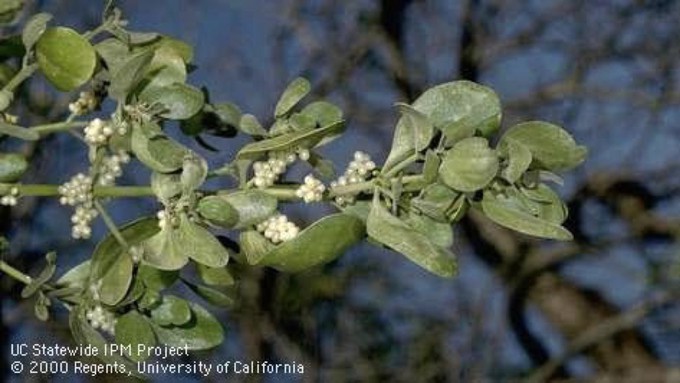
Berries from this parasitic plant (and popular holiday decoration) feed hungry songbirds in winter

The white berries of mistletoe are excellent food for songbirds. Courtesy UCIPM, photo by Jack Kelly Clark
Forget about kissing; mistletoe is for the birds.
Forever tied to romantic holiday traditions, this evergreen has a mixed reputation: Good for seasonal smooching, kiss of death for trees.
An evergreen parasite, mistletoe sucks water and nutrients out of its host tree, slowly contributing to the tree’s decline. It’s spread by birds that eat the plant’s sticky white berries and poop out seeds on branches. (“Mistletoe” derives from the early Anglo-Saxon words for “dung” and “twig,” or “dung on a twig.”)
Mistletoe – long considered a bane for foresters – actually may be a good thing for forest health and wildlife.
According to USGS research, forests with abundant mistletoe have more nesting songbirds – in some cases, three times more nests were recorded. Why? Mistletoe berries may be the ultimate superfood for our feathered friends.
All 10 essential amino acids have been found in mistletoe berries as well as lots of carbohydrates. That feeds birds in winter when little else may be available.
Tangles of mistletoe also provide nesting areas. Their “roots” where they attach to the tree create more nesting cavities.
Other animals are dependent on mistletoe, too. Squirrels and chipmunks love its berries. Deer and elk eat its leaves. Mistletoe flowers support honeybees and native bees as well as butterflies, say the researchers.
Meanwhile, mistletoe’s effect on host trees is not as extreme as commonly thought. As an evergreen parasite, leafy mistletoe species produce some of their own food through photosynthesis. Its dependent on its host tree’s survival; otherwise, it loses its source of water and other nutrients. Mistletoe can grow on a large oak for decades without killing the tree.
(Dwarf mistletoe, which is nearly leafless, can be a lot more destructive to its host tree.)
More than 1,500 species of mistletoe have been identified worldwide. Most of the mistletoe we see in Sacramento is broadleaf mistletoe (Phoradendron macrophyllum). Its berries are especially popular with cedar waxwings and robins.
The nation’s most common species is American mistletoe (Phoradendron serotinum), which ranges from New Jersey to Florida to the Southwest. Native to Mexico, it commonly attacks oak trees across North America.
American mistletoe also conquered the holiday market. It’s commercially harvested and sold worldwide as “Christmas mistletoe.”
Some nearby mistletoe are not native. “An exotic species of broadleaf mistletoe, Viscum album, was intentionally introduced by Luther Burbank at the turn of the 20th century and can be found in Sonoma County parasitizing alder, apple, black locust, cottonwood, maple, and pear trees,” says the UC Cooperative Extension pest notes.
Despite its positive impact on birds, mistletoe can be problematic. According to UC Cooperative Extension master gardeners, broadleaf mistletoe can infest several different kinds of landscape trees including alder, ash, birch, box elder, cottonwood, locust, silver maple, walnut and zelkova plus some varieties of flowering pear. Modesto ash in particular is very susceptible. In the Sierra foothills, dwarf mistletoe (Arceuthobium spp.) infests pines, firs and other conifers.
“Broadleaf mistletoe absorbs both water and mineral nutrients from its host trees,” say the master gardeners. “Healthy trees can tolerate a few mistletoe branch infections, but individual branches may be weakened or sometimes killed. Heavily infested trees may be reduced in vigor, stunted, or even killed, especially if they are stressed by other problems such as drought or disease.”
New, young trees, which can be stunted by mistletoe, are at risk from infestations of nearby older trees.
The most effective control? Pruning. Cut out infected branches, particularly while the mistletoe plants are small. If a tree is badly infested, remove the whole tree, say the master gardeners.
Some trees are rarely if ever infested. That includes Bradford flowering pear, Chinese pistache, crape myrtle, eucalyptus, ginkgo, golden rain tree, liquidambar, sycamore, redwood and cedar.
For more about mistletoe, check out the UC Cooperative Extension pest notes: http://ipm.ucanr.edu/PMG/PESTNOTES/pn7437.html.
Comments
0 comments have been posted.Sacramento Digs Gardening to your inbox.
Sites We Like
Garden Checklist for week of July 21
Your garden needs you!
* Keep your vegetable garden watered, mulched and weeded. Water before 8 a.m. to reduce the chance of fungal infection and to conserve moisture.
* Feed vegetable plants bone meal, rock phosphate or other fertilizers high in phosphate to stimulate more blooms and fruiting. (But wait until daily high temperatures drop out of the 100s.)
* Don’t let tomatoes wilt or dry out completely. Give tomatoes a deep watering two to three times a week.
* Harvest vegetables promptly to encourage plants to produce more. Squash especially tends to grow rapidly in hot weather. Keep an eye on zucchini.
* Pinch back chrysanthemums for bushy plants and more flowers in September.
* Remove spent flowers from roses, daylilies and other bloomers as they finish flowering.
* Pinch off blooms from basil so the plant will grow more leaves.
* Cut back lavender after flowering to promote a second bloom.
* It's not too late to add a splash of color. Plant petunias, snapdragons, zinnias and marigolds.
* From seed, plant corn, pumpkins, radishes, winter squash and sunflowers.